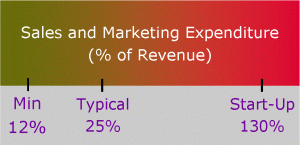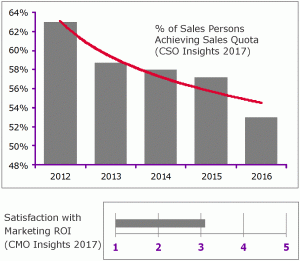Sales and Marketing Strategy | An Optimisation Approach
 Too often managers are left to make crucial decisions in sales and marketing strategy with little in the way of reliable data, marketing analytics, and/or rigorous models to guide their choices.
Too often managers are left to make crucial decisions in sales and marketing strategy with little in the way of reliable data, marketing analytics, and/or rigorous models to guide their choices.
As a result Sales and Marketing becomes overly reliant on mental models, intuition, and experience.
And while the value of experience cannot be underestimated, there is no objective way of choosing and mediating between the experiences of the many organisational stakeholders.
 Furthermore, mental models have been shown to be the most prone to systematic error.
Furthermore, mental models have been shown to be the most prone to systematic error.
Complicating this even further is responsibility bias; where sales managers might choose lower advertising budgets in favour of higher expenditures on personal selling, while advertising and marketing managers might prefer larger advertising budgets.
Finally, the overwhelming evidence is that most managers feel that their efforts are not delivering the sales and marketing effectiveness required.
Marketing Strategy Effectiveness | Fundamental Questions
Looking firstly at Marketing Effectiveness; it’s clear that the fundamental decisions driving marketing strategy effectiveness revolve around choices and questions such as …
Customer Value Management
? How does the organisation map and understand the value it delivers.
? How can this value be fully monetised.
? Where are the gaps in value creation and delivery.
? How does the organisation embed value creation in its skill-set and operations.
Portfolio Management
? How does an organisation build a product and service portfolio that maximises segment share and profitability.
? What are the best practices for portfolio management.
Marketing Expenditure
? How can the organisation align marketing spend with strategic priorities.
? How should marketing effort and expenditure be allocated across regions and products.
? How should marketing expenditure be allocated across platforms and media.
Marketing Evaluation
? What marketing metrics align with the organisation’s strategic direction.
? How can the organisation measure Return on Touch Point Investment (ROTPI).
In each of these decision spaces our Sales and Marketing Practice aims to embed client organisational capability and drive marketing effectiveness.
Sales Force Effectiveness | More than just Compensation and Training
Next looking at sales force effectiveness; a common misconception limiting the performance of many sales organisations is that all they need to do to fix the sales force is change the compensation plan, provide some training, and shuffle some accounts and sales staff.
While all of these are important, by themselves they are almost always insufficient in delivering significant revenue and/or profit growth.
Sales leaders often fall into this trap because compensation reviews and sales training are perceived as less disruptive; when compared to more structural but effective initiatives and strategies.
The main reason that organisations must now go beyond compensation and training is that sales has become an increasingly complex business function.
And a multitude of forces—including product commoditisation, buyer sophistication, global competition and an explosion in digital and web-based technologies and data— have totally upended the traditional sales environment.
This disruption of the traditional sales environment will require key stakeholders to address a number of key questions …
Shaping the Sales Force
? Given these disruptions, what should now be the purpose of the sales force. How should they add value. What are the implications for sales force design and skill sets.
? Do we have the right customer and market insights to develop a sound sales and pricing strategy and to direct the re-purposed sales force.
? How does the organisation go beyond legacy approaches to optimise the size and architecture of the sales force; including territory design.
Insight into the Sales Force
? What does the current sales process tell us about sales force productivity and effectiveness. How should the sales process be re-configured to actually add value, and to rapidly surface failings and bottlenecks.
? How good is sales integrated with the other key organisational functions. What’s missing and what need to change and improve. How can this be objectively managed.
Energising the Sales Force
? When was the last time the organisation actually measured the quality of teamwork, leadership, alignment, and culture of its sales force.
? What leadership practices, skills, and processes align with re-purposed sales organisation.
Enabling the Sales Force
? How effective are the sales tools available to the sales organisation. What needs to improve. Which tools enable the re-purposed sales force.
? What pricing tools are required to enable the sales force to optimise and review pricing options correctly and efficiently.
Managing the Sales Force
? Accounting for territory size and design, account size and types, relative competitive pressure, sales skills and experience, and other critical factors how can true sales and price efficiency be measured. What learnings are surfaced and how can true best-practices be replicated.
? How will compensation planes need to change to align with the re-purposed and re-configured sales force.
Now more than ever the sales organisation cannot continue to be one of the most poorly understood and under-optimised areas of a business organisation.
Sales and Marketing | Our Optimisation Approach
Our Sales and Marketing Practice leverages our capabilities in quantitative research, decision support modelling, and optimisation algorithm development.
In essence we combine research and predictive models to help identify where and how much of today’s sales marketing effort should be directed to yield the highest future returns.
To learn more about how we can optimise your organisation’s sales and marketing strategy to deliver sales force productivity and marketing effectiveness please contact us. Or click through to our Marketing Optimisation or Sales Optimisation pages.
